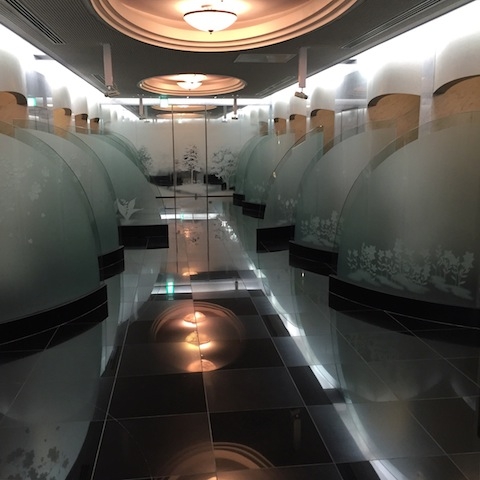At the beginning of this year I travelled to Japan for my grandfather’s 100-Day Ceremony (a remembrance service that occurs according to Buddhist custom 100 days after a cremation), which took place in a nondescript building, of the type that would usually be filled with offices, close to the centre of Yokohama. On the first floor was a reception and a shop selling funerary accessories, on the second was a hall and on the third, contained within one large room, was a traditionally decorated Buddhist temple where the prayers took place. On the fourth and fifth floors (and also underneath the building, but that part was hidden) was a mechanised columbarium: a structure used to house urns of funerary ashes. In Japan these places are known as nokotsudo (‘bone-receiving hall’) or, more recently, ohaka no manshon (‘house of ghosts’). After the ceremony, the urn containing my grandfather’s bones was brought into a room on the fourth floor of the columbarium, a modern space with white marble-effect walls and polished black granite surfaces, and two rows of five mourning spaces, each partitioned off by a curved sheet of opaque glass engraved with flowers. Behind one of these the priest placed my grandfather’s urn inside its tomb – a small, rectangular steel box lined with foam, with space for my grandmother one day too – and with the push of a button he sent it through the wall and down into the underground vault where it will hopefully reside, intermittently, for eternity. Intermittently because we can return to this room anytime, to any of its ten mourning spaces, and with a swipe of our contactless identification card the tomb will be conveyed back up to us. Hidden behind the walls of this building is a sort of vast automated hearse, interring and disinterring these miniature tombs with the same ease that the robots of the Amazon warehouse move around consumer electronics.
The mechanised columbarium, like the modern museum, is a well-lit repository of carefully preserved memories
The mechanised columbarium, like the modern museum, is a well-lit repository of carefully preserved memories. Visitors come to see only one object each, but will return to see it many times during their lives. Unless somebody has summoned your remains up from the ground to be remembered, they stay down there, inaccessible and out of sight, so there is privacy with this shared space; in the temple downstairs my grandmother mentioned how in Europe strangers are always walking over your grave – she was thinking of tombstones incorporated into the floors of cathedrals – and that she wouldn’t like that very much. Here the pristine spaces of commemoration resemble a sci-fi Mariko Mori installation, the shiny mourning spaces portals into the spirit world and the past. Thousands of strangers will come to reconnect with their personal histories and specific emotions – happiness, sadness, shame, regret – in a communal space serviced by robots. It really is an extraordinary setting. Hanging above four of its mourning spaces at a respectful remove are four white video cameras, allowing you to remotely summon your family tomb out of the ground and live-stream it to your computer. Thus the private act of commemoration can be performed virtually, which seems fitting for the age of assassination by drone, mass online outpourings of public grief over the death of a famous person and globalised video sex.
So this is a building with an unusual relationship to different sorts of space. It has its architecture within architecture: the Buddhist temple in a room, where the company’s clean minimalism is dramatically abandoned in favour of a transcendent, spiritual atmosphere of golden walls, burning incense, ringing gongs and chanting. It has its thousands of tombs moving around one building, which is a neat solution to the conundrum of where to bury the dead in a country that lacks space, and has an ageing population and an enduring passion for technological innovation; the first mechanised columbarium was opened here in Yokohama, and others have followed across Japan and also in Singapore, Malaysia and Indonesia. Hong Kong has investigated following suit. Everything is so physically compact and yet because it is a moving columbarium and because its premises can be accessed virtually, the architecture allows the bridging of vast distances between the living and the spirit world, both literally and metaphorically. This really is a house of ghosts, and a glimpse of one possible future for death in our crowded cities.
This article first appeared in ArtReview Asia vol 4, no 2.
